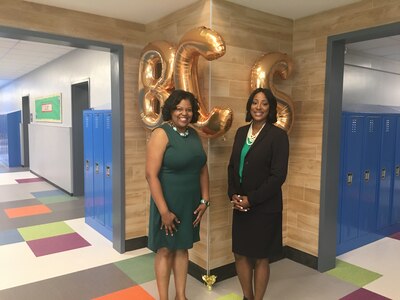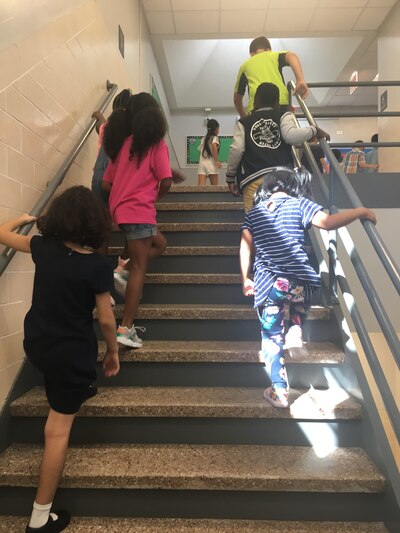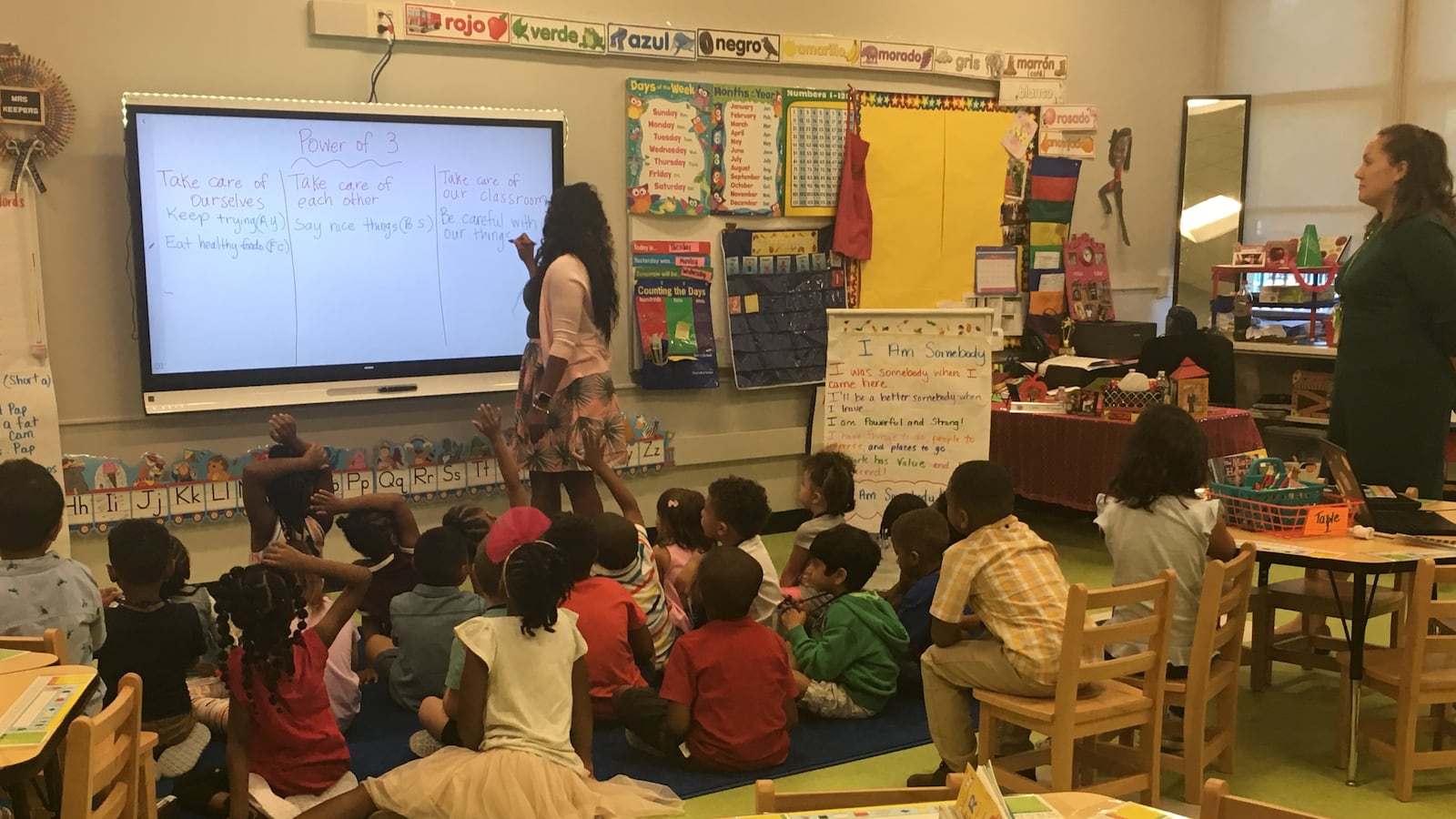The first day of school, Nicole Spicer woke up at 4 a.m., put on a kelly-green blouse that matched her school colors, and was greeting new families at the door by 7:30 a.m.
By 9:30 a.m., the founding principal of the new Bronzeville Classical Elementary had run the school leadership gauntlet: encouraging her small cadre of teachers, welcoming jittery students and parents, and throwing an opening-day party complete with a balloon trellis and visits from such VIPs as Mayor Rahm Emanuel and Chicago schools CEO Janice Jackson.
Her venti Starbucks coffee had long grown cold. So she headed to the teachers’ lounge to zap it in the microwave before embarking on another tour of the building, a former elementary school that closed under former schools chief Arne Duncan, reopened as a charter, then closed again.
In the school-choice era in Chicago, school buildings can have many incarnations, and 8 West Root Street’s latest says a lot about what parents in and around Bronzeville want. The only new selective enrollment school opening this year, it comes amid amped-up debate about the degree to which test-in schools pick off accelerated learners and middle-class families at the expense of neighborhood programs.
The debate recently has been stoked by reports that paint a never-before-seen picture of supply and demand in individual schools as well as the startling number of open seats in neighborhood schools.

A case study in what a school can look like with robust support, Bronzeville Classical’s deep bench consists of black religious and business leaders from the community around it. A multimillion gut rehab puts its facilities-wise on par with private schools — there are smart boards in classrooms, a new playground and turf area, even a donated pottery kiln. And the principal has ties with the historically black neighborhood, which still really matters in Chicago.
“Bronzeville has always been a part of who I am,” said Spicer, who grew up near 41st and Indiana streets and attended Catholic schools in the area, despite family who were alums of Phillips High School. “I couldn’t pass up this opportunity.”
The opportunity she’s describing is building a school from the ground up, from hiring the staff to prioritizing Spanish-language immersion and music theory to recruiting the students. Since the school was announced last December, Bronzeville Classical has enrolled 80 children in grades K through second, with plans to add a grade each year. It still has 100 students to go to reach its initial goal.
To recruit more families, Spicer is setting up her front office to help families navigate the selective-enrollment process, which includes completing a centralized online application and registering children for a testing appointment at a facility near IIT. There will also be orientations for prospective families, tours, a social media push, and workshops for families, said Assistant Principal Raven Talley. “When you walk into a school, you want to feel and see the community and the culture,” Talley said.
Not everyone who lives in the surrounding neighborhoods can attend the school, no matter the supports. That bothers public education organizers like Jitu Brown, the national director for the Journey for Justice Alliance. He has long encouraged CPS to stop segregating students by test scores and shower its neighborhood schools with the same resources and attention it gives new schools. “The rest of our babies are left to languish in neighborhood schools that are starved.”
In essence, other schools could use smart boards and Spanish immersion. A balloon trellis wouldn’t hurt.
The parent perspective
Brittany Smith, the parent of a first-grader at Bronzeville Classical, sympathizes with that argument. But, at 27, she’s part of a generation that came up in the choice era, traveling to a magnet school as an elementary student that was near the Indiana border and then attending Whitney Young, the city’s first public magnet high school.
In other words, “I’m used to the idea,” she said.
Smith lives in Bronzeville, just down the street from Ida B. Wells Preparatory, which reported an average kindergarten class size of 38 last year (the district average was 16.9, according to the 2017 Illinois School Report Card.) Put off by the class sizes, she tested her daughter and gained admission into a selective-enrollment school that was a 20-minute drive from her house. When she heard about Bronzeville Classical, which would be less than 5 minutes away, she applied. “I can tell there is a lot of support from the teachers and the principal, and it’s in the neighborhood.”
For many families, the decision to transfer to a new school with no record is not made lightly. There’s no word of mouth and no test score data to compare, though classical schools — which teach a grade level above, focus on language, and usually have strong art and music programs — are consistently among the district’s highest performing.

A few days in, both Smith and another parent, Alicia Blais, who lives in McKinley Park, feel encouraged. Smith, who is black, appreciates the diversity of the school (numbers aren’t fully in, but an early measure shows the school at 50 percent black, 20 percent Asian, and 10 percent white, with a third of the students qualifying as low-income), the sparkling facility, and the fact that her daughter comes home happy.
Blais, who is white, says Spicer and her assistant principal are working with her to provide the right experience for her daughter, who is highly sensitive. Already, the first grader has really connected with the Spanish teacher. Calling it a “last stop” before moving to the suburbs, Blais said, “We are one of many parents who need this school to work.”
Design from the ground up
The siren call of a new school doesn’t just lure parents. Educators hear it, too. An award-winning reading specialist who formerly served as assistant principal at another classical school, Skinner North, Spicer participated in a highly competitive process for the principalship. It culminated with her speaking in a public forum last spring alongside another finalist.
After getting the job and taking what she describes as a “listening tour” of community organizations, she approached hiring her small staff with the same careful scrutiny: sorting through hundreds of applications to find a diverse roster of candidates. She opted for full-time music, PE, and Spanish in addition to her K-2 classroom teachers, special education teacher, and a counselor. In lieu of full-time art, a nonprofit group will come in and teach one day a week. (An alum of Golden Apple, the prestigious Illinois teacher training program, Spicer said three of her hires share those ties)
For Jessica Lyons, the Spanish teacher, who previously taught in a Catholic school, the chance to build curriculum from the ground up was persuasive. So was Spicer’s vision of earning a Seal of Biliteracy. For her, that means teaching classes completely in Spanish and cultivating a positive mindset around learning languages through books like “La Vaca Que Decía Oink,” about a cow that says oink. “I’ve designed Spanish programs at schools before, but this is an opportunity to really start something from the ground up and have ownership over it.”
Music teacher Reginald Spears has been working in Chicago schools for a decade, most recently at the nearby Doolittle Elementary. He brings with him a vision for a musical curriculum that prepares children for elementary band, or orchestra, complete with sight reading and songwriting. At some schools, music is viewed as a vehicle to teach reading or math, he explains — here, it’s a subject worthy of its own study and exploration.
He also brings training in calm classroom techniques, such as breathing and stretching, that he has shared with his fellow teachers. “I’m excited that this going to be part of the school.”
But despite the gleaming hallways and pottery kiln, Bronzeville Classical is still a public school in Chicago and can’t escape the realities of the district’s ongoing budget crunch. So Spears’ ambitions of a piano lab and a suite of shiny instruments might require some creativity. He plans to start the way teachers across the city do — a crowdsourcing page on the website Donors Choose.org.

